If you’re planning a holiday in the south of France, Marseille is a beautiful place to stop or stay in. The area is known for its exceptional beaches and sunny coastline, thanks to the Mediterranean climate, and Marseille is a city filled with things to see and do.
Driving to Marseille from Calais
The drive from Eurotunnel Le Shuttle's Calais terminal to Marseille takes around 10 hours and 30 minutes, via the A26 and A7, and offers an exciting cross-country view of France.
As one of the main cities to visit in southern France, you also travel past two other major cities; Paris, and Lyon. So instead of just a one-off stop in Marseille, why not make this a holiday to really remember and stop there too?
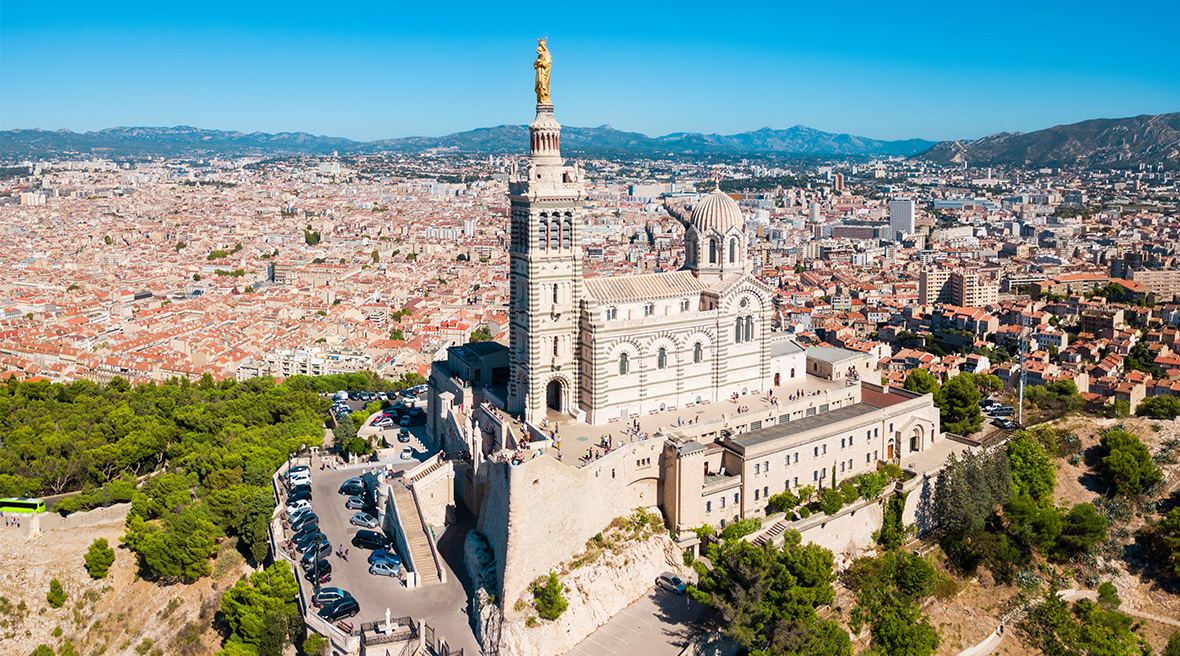
Notre-Dame de la Garde rising above the city
A brief history of Marseille
With a wealth of historical architecture and museums celebrating its long history, it’s no surprise that the city gained the title of European Capital of Culture in 2013.
The city dates all the way back to 600 BC, when the Greeks founded the area and named it Massalia, took over the old port in 540 BC, and established a thriving central port and trading area. Later, Marseille prospered as a Roman city, becoming an early centre of Christianity during the Western Roman Empire.
Thanks to its exceptional trade record, Marseille remained independent for a long period of time. It wasn't until King Louis XI inherited Marseille, after the death of Count of Provence René d'Anjou, that the city became part of France in 1482.
Although the city suffered greatly during the Black Death of the 14th century, the Middle Ages and Renaissance saw it regain much of its wealth and trading power. It was influential for industrial innovation and manufacturing in the 19th century and, although bombed by German and Italian forces in WWII, was rebuilt in the 1950s.
Today, Marseille is so much more than the sum of its parts, with beautiful discoveries around every corner.
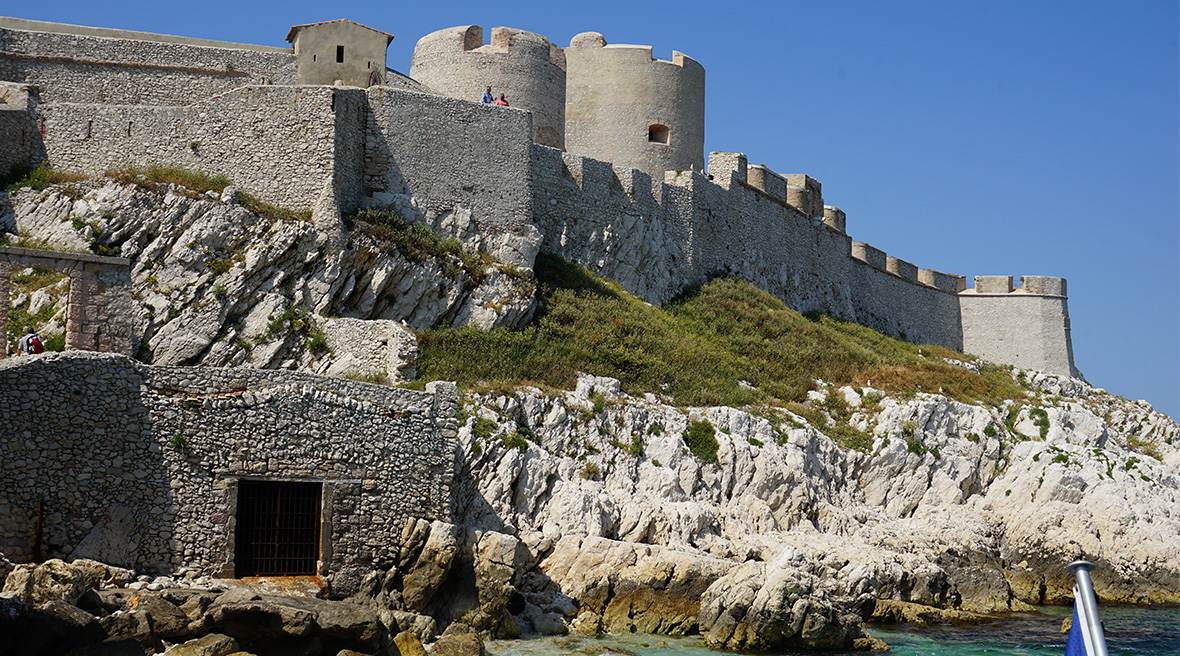
The impressive Château d’If is a fascinating place to explore
Historical sites to visit in Marseille
The city is filled with history but be sure to stop at these places during your trip to see the very best Marseille has to offer.
Notre-Dame de la Garde
The Basilique Notre-Dame de la Garde dominates the skyline of Marseille at its highest point. This Neo-Byzantine church, built on the foundations of a 16th-century fort, is known as the protector of the city. Inside murals predict the safe passage of sailing boats and its north face bears the scars of Marseille's Battle of Liberation in 1944.
No matter where you go, you will see the landmark church set on the highest point of the city. It remains the standout symbol of Marseille, since its inception in 1853, and plays host to an annual pilgrimage on the 15th of August.
The Notre-Dame de la Garde is deemed the most visited site in the city as it welcomes hundreds of people each day. Look to the top of its bell tower to see a 30ft-high statue of Virgin Mary, coated in gold leaf.
The church is free to enter and is open every day from 7am to 7:15pm during Apr-Oct and 7am-5:30pm during Nov-March. Take the short 1km walk from Vieux Port to the church and enjoy panoramic views across Marseille. Or, for a more leisurely trip, hop on the tourist train or number 60 bus up the hill.
Fort Saint-Jean
Fort Saint-Jean was built by Louis XIV at the entrance to the Old Port. During the French Revolution, it was used as a prison and later taken over by the French army (19th and 20th centuries) and used as a barracks and clearing station for the Army of Africa.
Today it houses one of three sites of the Mucem in Marseille (Museum of European and Mediterranean Civilisations). You can climb to the Salle du Corps de Garde (guardhouse room) in the upper levels of the fort to watch videos about the building's history and architecture. Wander around beautiful, landscaped grounds and the Garden of Migration to get a sense of the layers of history underfoot.
When you're finished in the fort, cross the footbridge to the reach MuCEM's additional space on J4 pier, designed by architect Rudy Ricciotti. Here you'll find a permanent exhibition exploring the historical significance and diversity of Mediterranean civilisations.
Cathédrale de la Major's beautiful domed towers
Also known as Marseille Cathedral, this national monument is totally unique. The only cathedral built in France in the 19th century, it was built in a Byzantine style and is one of the largest churches in the country too. Construction took place between 1852 and 1893, when Marseille was the first port in France and the stopover point for ships from all over the world, the first stone was laid by Napoleon III himself.
The bell towers and domes are wonderful from both inside and outside the building, made from white marble from Carrara, porphyry and onyx from Italy and Tunisia, mosaics from Venice, and green stones from Florence.
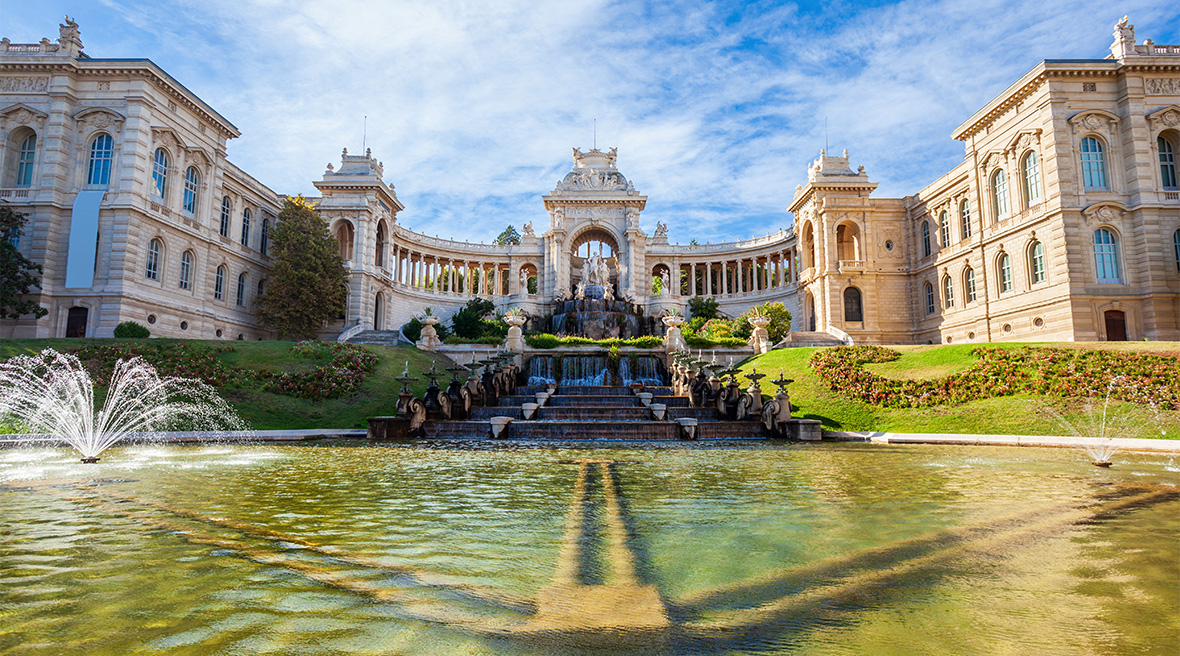
The beautiful Palais Longchamp
Explore the 16th-century castle of Château d’If
Built upon an island just off the Marseille coastline, Francis I of France commissioned the Château d'If built to protect the coast from invasion as well as provide cover for his then new royal fleet of galleys in 1524.
It was then used as a state prison for ‘anyone opposing official authority’ from 1580 until 1871. Gunnery towers were built within the walls which remain today, even though no attack ever took place at the fort, and it has weathered the centuries nearly untouched.
The prison was eventually closed, and the fort was reopened to the public as a landmark in 1890. If you’ve read The Count of Monte Cristo, you’ll certainly recognise the name of this impressive fortress as where the story’s protagonist, Edmond Dantès, is imprisoned. A former cell has even been designated as the one where the count was held, despite the man’s fictional qualities.
Marseille's oldest museum, Palais Longchamp
The Palais Longchamp was created to celebrate the construction of the Canal de Marseille, which brought water from the Durance River to Marseille. Its foundation stone was laid by the Duke of Orleans on 15th November 1839, but the building took 30 years to complete. This isn’t hard to understand when you visit, as it is expansive, housing both the Musée des beaux-arts and Muséum d'histoire naturelle de Marseille and surrounded by elaborate fountains and gardens.
Designed by the architect Henri-Jacques Espérandieu, he began with the most prominent fountain known as the château d'eau (water castle). The surrounding parkland is listed by the French Ministry of Culture as one of the Notable Gardens of France.
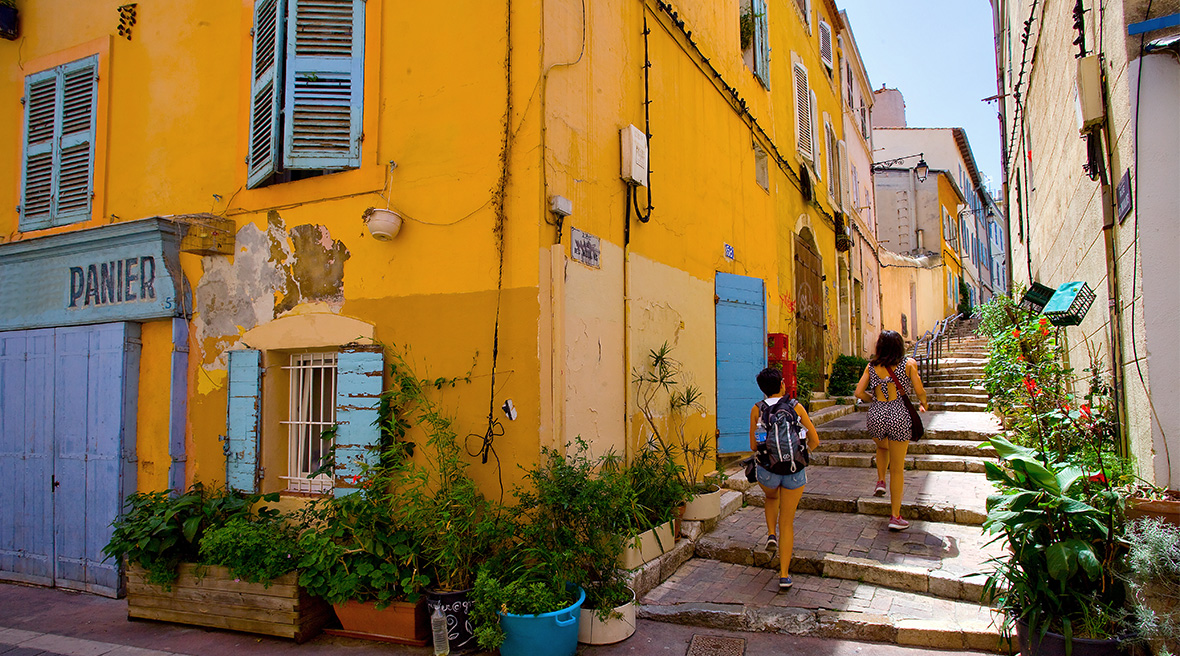
Explore the older parts of the city like Le Panier
Points of interest
From natural spaces to sporting venues, there’s so much to see in Marseille. Put these places at the top of your list to visit.
Stade Vélodrome
Whether you're a football fan, an admirer of sport or just being encouraged to tag along, Marseille's home stadium doesn't disappoint. The 60,000-capacity stadium is the second largest in France and was even renovated to increase its size.
In a city where football is the hot topic on everyone's lips, it's best to join in the fun and see what the fuss is about. To watch one of Marseille's games, ticket prices vary from match to match but are usually between €32 to €92. For a cheaper alternative however, you and your family can enjoy a tour of the stadium for around €10 each.
Calanques National Park
Arguably one of the most beautiful sights in France, the calanques are steep-walled inlets described as rough diamonds, found along the coast between Marseille and Cassis. It's perfect for hikers and walking enthusiasts if you decide to take the trail on foot, as you are required to scale a 17.4-mile-long track that traverses the calanques.
If you want to save your feet, then you can always hop on board a boat. For around €25, you can pay for a trip to see eight calanques in 90-minutes, but prices vary dependent on which boat company you choose. A boat ride, majestic cliffs, and the deep blue sea are everything you need for a spectacular day out.
The Vieux Port
Today, Marseille is the second-largest city in France, after Paris, and its largest commercial port. The city grew from Vieux Port (Old Port) and ships have docked there for almost 3,000 years, making this a historically rich area. You'll see throngs of fishing boats selling their fresh catch of the morning, and plenty of pleasure boats filling the old port.
Visit Marseille's Old Town, Le Panier
The sloping streets of Le Panier (the old Greek quarter) saw the beginning of Marseille. The old and tall houses represent where the ancient Greeks settled around 600BC. On Rue de la Prison, you will discover La Maison Diamantée, a beautiful 16th-century civilian palace with a facade featuring diamond facets, plus the old town has many shops and eateries to enjoy.
La Canebière
La Canebière is the historic high street in the old quarter of Marseille. It was part of King Louis XIV’s expansion of the city and later, when the 19th century saw an intense period of construction, it benefitted from the opening of the Suez Canal in 1869 when trade with North Africa was at its peak.
Take some time to browse the markets and sample delicious North African cuisine here. The colourful food market at Noailles is one of the best and can be found along the narrow streets around La Canebière, close to the Old Port. Even better, it's open every day.
L’Estaque
This village just west of Marseille is particularly attractive to art lovers as many artists of the Impressionist and Post-Impressionist periods visited or lived here including Paul Cézanne and Georges Braque.
The views over the bay of Marseille are incredibly beautiful and walking tours are available to discover more about who’s stayed and which works of art were inspired by this pretty port. The ‘painters’ path’ takes around two hours to complete.
La Plaine and Noailles
Directly east of the city’s old port sits two neighbourhoods that are worth visiting to get a glimpse of day-to-day life in Marseille.
Noailles is where generations of Africans settled after Algeria became a French territory in 1830. A market here runs from Monday to Saturday, with sights and scents that will transport you to a souk in North Africa or the Middle East. It’s colourful and a little chaotic, but in the most charming way.
La Plaine is a trend-setting area a few streets further east, filled with stylish boutiques and bars. It also has a popular market on Tuesdays, Thursdays, and Saturday mornings with a jumble of stalls selling everything from fruit and veg, to fashion and ceramics.
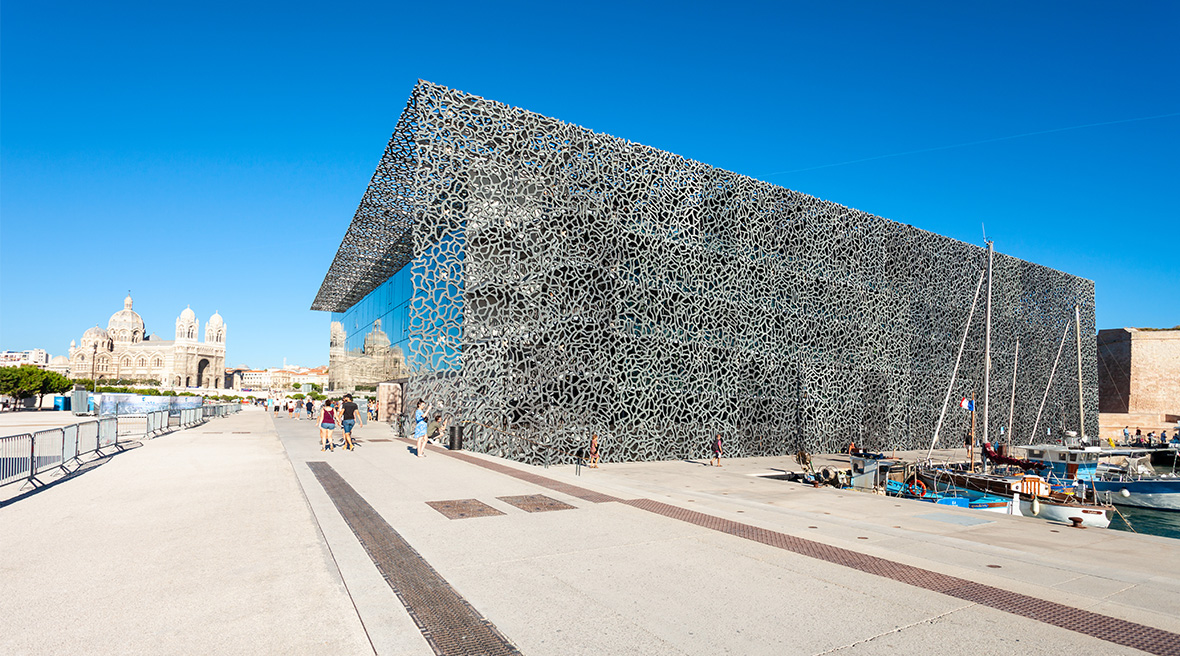
The MuCEM is worth a visit just to see the building itself
Museums and galleries
For a full day of culture, wander any of the museums or art collections in the city. They’re also perfect for rainy or colder days during your trip.
Musée d’Histoire de Marseille
The Marseille History Museum is the city’s local historical and archaeological museum. It opened in 1983 as the first town historical museum in France, to display the major archaeological finds discovered when the site was excavated in 1967 for commercial redevelopment and the construction of the Centre de la Bourse shopping centre. You enter the museum building from within the centre.
Be sure to visit the Jardin des Vestiges, a garden containing the stabilised archaeological remains of classical ramparts, port buildings, and a necropolis.
MuCEM
The MuCEM, which stands for Musée des Civilisations de l'Europe et de la Méditerranée, opened its doors in June 2013, the year that Marseille was designated the cultural capital of Europe. The museum focuses on the European and Mediterranean civilizations from Early Antiquity to present-day and is housed in an ultra-modern building close to the historic harbour in the city centre. The gardens, cafés, and restaurants are all part of the complex and a great place to spend time. There is also a popular open-air theatre.
Musée des Docks Romains
The Musée des Docks Romains explores the site of one of the world’s few known Roman commercial warehouses. Uncovered after the war, during which much of Marseille was bombed, here you can see objects discovered on underwater archaeological excavations, several from the wrecks of ships that sank off the coast of Marseille.
A highlight is the dolia, uncovered in 1947, which are massive ceramic jugs (some as tall as 6 feet) used to store up to 2,000 litres of wine or olive oil.
Marseille Museum of Contemporary Art (MAC)
If you're looking for a little culture, there is no better place to go to see Marseille's take on modern art. The museum opened in 1994 and showcases art from major French and international artists from 1960s onwards. Within a garden full of artistic statues, there are plenty of sights on offer for the whole family to enjoy.
For even more art, just 20 minutes away is a 19th century mansion, The Musée Grobet-Labadié, a palace which displays rich collections from its former wealthy owner. Tapestries and chinaware help paint a picture of 18th-Century wealth in France.
Explore Marseille with Eurotunnel Le Shuttle
Ready to venture to Marseille? Eurotunnel Le Shuttle can get you from Folkestone UK to Calais France in just 35 minutes. From there you are ready to experience this phenomenal city.
Book your journey